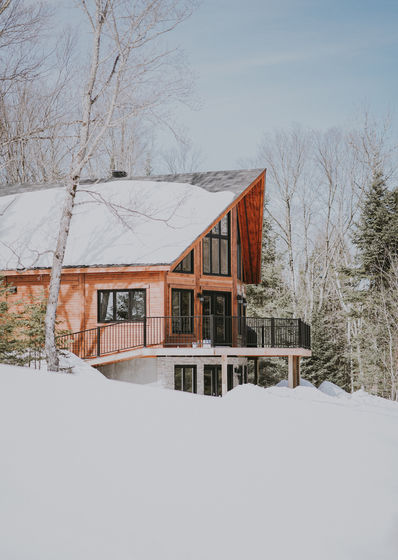To survive the cold winter, it is much more economical to dress properly than to raise the temperature setting on the heating.

With the arrival of full-fledged winter, there are more opportunities to use heating equipment such as air conditioners, and many people are likely to feel the rise in electricity costs. To survive such cold winters,
Insulation: first the body, then the home - LOW-TECH MAGAZINE
https://www.lowtechmagazine.com/2011/02/body-insulation-thermal-underwear.html
Over the past few decades, the performance of home insulation and the energy efficiency of heating equipment have improved relatively, which has significantly reduced energy consumption. For example, in the United States, despite population growth and improved comfort levels, energy consumption for heating equipment decreased by approximately 19% from 1993 to 2005, and similar trends are observed in other developed countries. It seems that you can see it.
However, heating equipment still consumes a large amount of energy, and most of it relies on fossil fuels. There are also claims that state-of-the-art housing equipment with high insulation performance can reduce energy consumption, but most of these claims do not take into account the energy consumption of demolishing old buildings and building new homes. Low-tech Magazine points out.
In addition, homes that use cutting-edge insulation materials and energy-efficient heating equipment are expensive to begin with, so not everyone can afford them easily.

A simple way to deal with these problems is to lower your heating settings and wear more clothes. The amount of energy consumption you can save by lowering your heating set temperature will vary depending on the outdoor temperature, but even in mild climates, lowering your heating set temperature by just 1 degree can save you about 9 to 10%. It
The American Society of Heating, Refrigerating, and Air-Conditioning Engineers (ASHRAE) recommends that the winter room temperature be set between 21 and 23 degrees Celsius. According to a Dutch report, the average winter room temperature rose from 20 degrees Celsius in 1984 to 21 degrees Celsius in 1992. Although these data may not be enough to prove that room temperatures are rising, it is easy to imagine that improvements in heating equipment have increased comfort levels for many people over the years.
From 1993 to 2005, the energy consumption of heating appliances was reduced by about 20%. However, this only has the same energy saving effect as lowering the set temperature of your heating appliance by about 2 degrees. Low-tech Magazine recommends lowering the temperature setting on your heating device and wearing clothes, as lowering the temperature setting on your heating device from 22 degrees to 18 degrees can save you as much as 35% on energy consumption. That's why.

To begin with, the human body's deep body temperature is around 37 degrees Celsius, but the skin temperature is around 33 to 34 degrees Celsius. Skin temperature decreases because the environmental temperature is lower than body temperature. Heat is released through breathing and through the skin, but most of the heat is released through the skin, and to prevent this, many animals other than humans are covered with fur or feathers.
Wearing clothing is necessary to prevent heat radiation from the skin, but clothing itself does not generate heat; it only prevents body heat from escaping. This occurs by warming the layer of air between the skin and clothing, and air has a relatively poor thermal conductivity, making it an excellent insulator. In fact, your home's insulation system basically uses air in the same way. The difference in insulation methods between houses and humans is that for humans, the clothing that covers the skin needs to be light and easy to move in so that the body can move, but for a house, the clothing that covers the skin needs to be light and easy to move in, but in the case of a house, the clothes that cover the skin need to be light and easy to move around in. This allows the use of hard and bulky materials.
The insulation properties of clothing can be expressed in the unit 'clo'. Although this is not a standard international unit, 1clo is equivalent to 0.155m²K/W, and has the same insulation effect as wearing a three-piece business suit (shirt, pants, jacket) and thin underwear. In addition, 1clo means insulation properties that allow you to stay comfortably in an environment of 21 degrees Celsius. In Europe, there is a similar unit of insulation properties called 'tog', where 1 tog = 0.645 clo. It can also be compared with 'R' for building insulation, where 1clo = 0.88R.
According to the Occupational Safety and Health Encyclopedia, the insulation required to maintain a neutral temperature sensation is approximately 2.7clo at a room temperature of 10 degrees Celsius, and when the room temperature drops to 0 degrees Celsius, the insulation required to maintain a neutral temperature sensation is approximately 2.7 clo. It seems that the characteristics will increase up to '4clo'. According to ASHREA, for every 1 degree change in room temperature, the insulation properties of clothing change by about 0.18clo.

The rough clo values for each type of clothing according to ASHREA are as follows. You can calculate the insulation properties by simply summing the CLO values of the clothes you are wearing.
Short sleeve T-shirt: 0.10clo
Sleeveless underwear: 0.06clo
Bloomers for women: 0.20clo
Short sleeve shirt: 0.15~0.25clo
Long sleeve shirt: 0.20~0.30clo
Pants: 0.25~0.35clo
Long skirt/robe: 0.22~0.77clo
Sweater: 0.30clo
Briefs: 0.05clo
Socks: 0.04~0.10clo
Long sleeve underwear: 0.20~0.35clo
Tights: 0.20~0.35clo
In addition, Low-tech Magazine says that it is ``just a general rule of thumb'' and that the clo value is equivalent to 0.15 times the weight of the clothing (in pounds). However, with the development of materials engineering, lighter clothing with a higher CL value has appeared, according to Low-tech Magazine. Functional innerwear such as HEATTECH, which is extremely popular in Japan, is a type of ``lightweight clothing with a high clo value.'' Although there is no exact documentation of the clo value for functional innerwear, etc., it is approximated at approximately 2x.
In addition, long T-shirts and tights that fit perfectly to the body have the optimal 'pumping coefficient.' The pumping coefficient is another factor in addition to the CLO value that defines the insulation properties of a garment, and is a measure of the air movement caused by the movement of the wearer. For example, tight-fitting underwear has a much better pumping coefficient than loose-fitting clothing such as ponchos and wide pants, so even clothes with similar CL values have a much higher insulation effect than clothing with a higher pumping coefficient. It seems that it will be higher. In addition, the insulation effect is higher when you are covered with multiple thin layers of air rather than a single large layer of air, so wearing underwear and clothing with a high CL value can improve the insulation effect. You can expect.

According to the U.S. Air Force Survival Book, if you wear two layers of long pants (0.25 to 0.35 clo), the clo value will be 1.5 clo, which will more than double the clo value and instantly increase the insulation effect.
In addition to room temperature, the required clo value changes depending on whether you are sitting still without moving your body or doing light movements such as typing. For example, if the room temperature is 10 degrees Celsius, you will need 2.7 clos if you are not moving, but if you are doing light activities such as typing, the required clo value will drop to about 1.7 clos. that's right. According to Low-tech Magazine, every 30 watts of heat production reduces your comfort temperature by about 1.7 degrees.
However, the temperature that people feel comfortable with varies greatly not only by gender and age, but also by individuals, so it is best to use the required clo value only as a reference. However, Low-tech Magazine notes that the insulating properties of properly worn clothing have a non-negligible effect and can be very effective in saving money.
Related Posts:
in Note, , Posted by logu_ii







